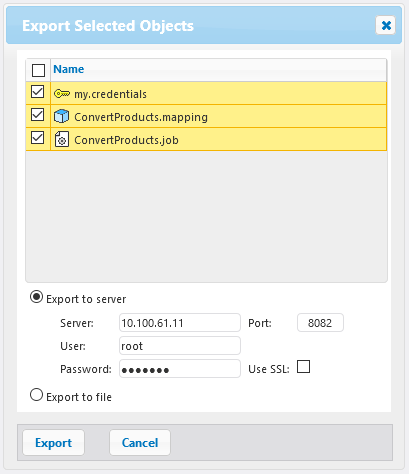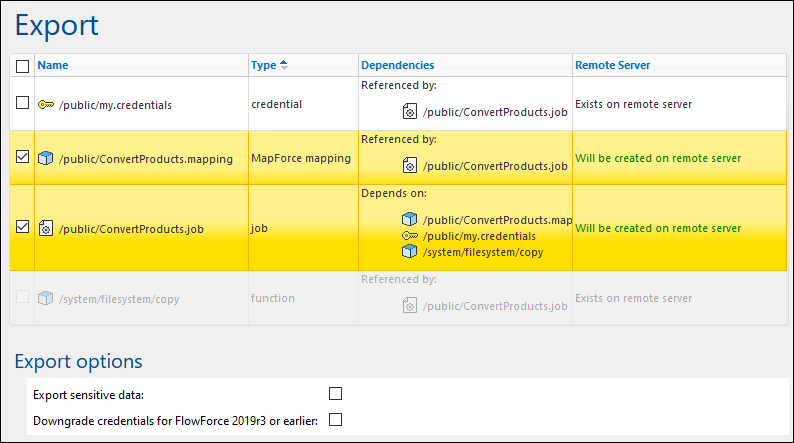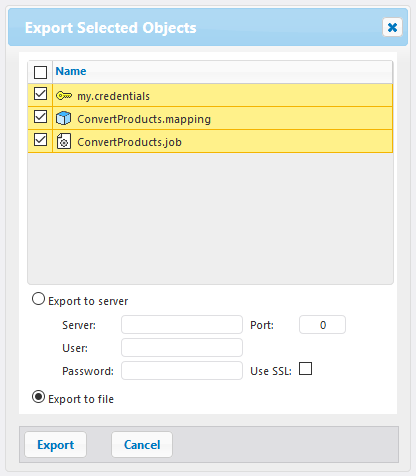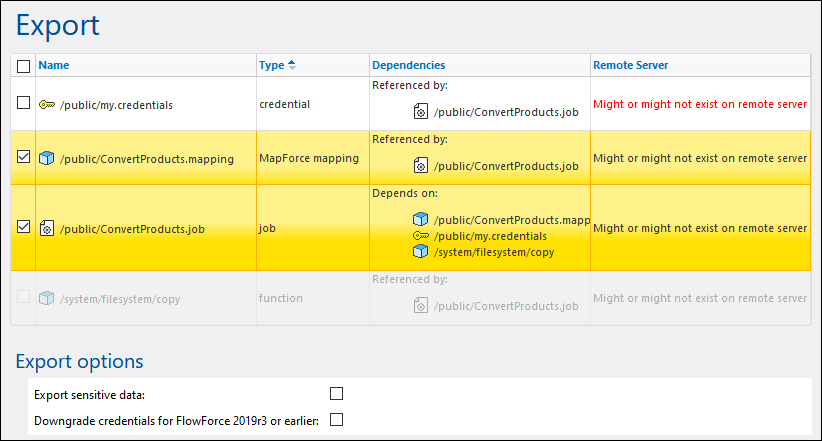Export Configuration Data
You can export either specific records within a container, or entire containers. In either case, FlowForce displays a dialog box that enables you to review the list of records before exporting them. If you selected an entire container for export, this dialog box displays all the children records of the selected container (jobs or credentials).
Before exporting objects, FlowForce informs you on a separate page about all objects that are dependent on (or are referenced by) the objects that you wish to export. This helps you see at a glance if there are missed dependencies. If you are exporting objects to a running FlowForce Server, you can also see whether each object already exists on the destination server.
By default, FlowForce Server does not export the following categories of sensitive data:
•Passwords defined locally in jobs •Passwords available as "standalone" credential records. •Passwords stored with system functions (such as /system/ftp functions) •OAuth 2.0 client secret, authorization token and refresh token •Private keys in a certificate+private key pair
To export all these categories of sensitive data, select the option Export sensitive data during export. Be aware that, if you select the check box, the exported archive will include the sensitive data in plain text form.
If you do not select the check box, the sensitive data will not be exported. Upon importing data back into FlowForce Server, you have the option to overwrite each individual record, or skip it. If you choose to overwrite, the existing sensitive data will be replaced with empty values. Namely, in case of credentials, the password will be empty. In case of certificates, the certificate will not have the private key. In case of OAuth 2.0 credentials, the client secret, the access token, and the refresh token will all be empty. |
To export configuration data to a running FlowForce Server instance:
1.Click Configuration, and select the records you want to export. You can select either specific records within a container, or the entire container.
2.Click Export Selected Objects.

3.In the dialog box, click Export to server, and enter the host name of the destination FlowForce Server, and the port where it runs.
4.Enter your user name and password on the destination FlowForce Server instance, and then click Export. FlowForce displays all records to be exported on a page where you can view their dependencies, or omit them from the export.

The records with a yellow background are those that are being exported. The record without a yellow background are those that you have excluded from the export, by clearing their adjacent check box. Finally, the records that are grayed out represent dependencies on built-in system functions, so you cannot take actions on them.
The "Remote Server" column indicates if the file exists at destination. If the dependencies already exist at destination, you can safely omit such records from the export. Otherwise, if you are exporting without dependencies and the dependencies do not exist at destination, such jobs will likely fail, see also Worked Examples.
As mentioned above, the Export sensitive data option lets you optionally include passwords, certificate private keys, and OAuth sensitive data in the exported package. For security reasons, it is not recommended to select this check box unless you really need to transfer such sensitive data in plain text out of FlowForce Server.
The check box Downgrade credentials for FlowForce 2019r3 or earlier must be selected if the exported list includes records of type "credential" and if the target FlowForce Server is of version 2019r3 or earlier. After that release, credentials got new "Allow usage" options, and so the check box makes it possible to make newer credential records compatible with older versions of FlowForce. For more information about "Allow usage" options, see Defining Credentials.
5.Click to select the objects to be exported, and then click Start Export.
To export jobs to a file:
1.Click Configuration, and select the records you want to export. You can select either specific records within a container, or the entire container.
2.Click Export Selected Objects.

3.In the dialog box, click Export to file, and then click Export. FlowForce displays all records to be exported on a page where you can view their dependencies, or omit them from the export.

The records with a yellow background are those that are being exported. The record without a yellow background are those that you have excluded from the export, by clearing their adjacent check box. Finally, the records that are grayed out represent dependencies on built-in system functions, so you cannot take actions on them.
Because you are exporting to a file and not to a running FlowForce Server instance, it is not possible to determine whether the exported objects exist at destination. For this reason, the "Remote Server" column shows "Might or might not exist on remote server". If the dependencies will exist at destination when you import the .zip archive back into FlowForce, you can safely omit such records from the export. If you are not sure, choose to export all dependencies. Otherwise, when you later attempt to import data where dependencies are missing, the import will fail with an error like "Operation failed: Path does not exist". See also Worked Examples.
4.Click Start Export to File. Depending on your browser settings, you may either be prompted to save the .zip archive to a local directory, or the browser may save it automatically to a preconfigured destination directory.